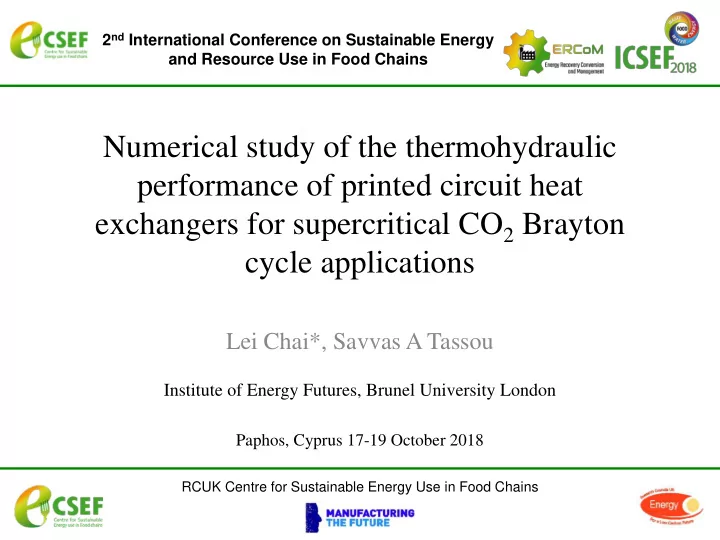

2 nd International Conference on Sustainable Energy and Resource Use in Food Chains Numerical study of the thermohydraulic performance of printed circuit heat exchangers for supercritical CO 2 Brayton cycle applications Lei Chai*, Savvas A Tassou Institute of Energy Futures, Brunel University London Paphos, Cyprus 17-19 October 2018 RCUK Centre for Sustainable Energy Use in Food Chains
2 nd International Conference on Sustainable Energy and Resource Use in Food Chains Outline • Introduction – Why sCO 2 ? Why printed circuit heat exchanger? • Computational method – Element, model, boundary condition. • Data acquisition – Local, average and overall parameters. • Results and discussion – Thermohydraulic performance, comparison with correlations. • Future work RCUK Centre for Sustainable Energy Use in Food Chains Lei Chai 2
2 nd International Conference on Sustainable Energy and Resource Use in Food Chains Why sCO 2 ? • working fluid with a high power density • smaller equipment sizes • smaller plant footprint • lower capital cost • use of standard materials • improved electrical-power- conversion efficiency RCUK Centre for Sustainable Energy Use in Food Chains Lei Chai 3
2 nd International Conference on Sustainable Energy and Resource Use in Food Chains Why printed circuit heat exchanger? Recuperator • increase the average temperature of the heat source • results in higher efficiencies RCUK Centre for Sustainable Energy Use in Food Chains Lei Chai 4
2 nd International Conference on Sustainable Energy and Resource Use in Food Chains Why printed circuit heat exchanger? • highly compact construction • high heat transfer coefficient • high pressure capability • wide range of operating temperatures RCUK Centre for Sustainable Energy Use in Food Chains Lei Chai 5
2 nd International Conference on Sustainable Energy and Resource Use in Food Chains Computational element and model • standard k- ε model • NIST real gas thermophysical properties • buoyant effect RCUK Centre for Sustainable Energy Use in Food Chains Lei Chai 6
2 nd International Conference on Sustainable Energy and Resource Use in Food Chains Boundary and operating conditions • Periodic for upper and lower surfaces • Symmetry for left and right surfaces • Mass-flow-rate for two inlet • Pressure-outlet for two outlet • Mass flux balances: 254.6 to 1273.2 kg/(m 2 ·s) • Cold side :100 ° C of inlet temperature and 150 bar of outlet pressure • Hot side: 400 ° C of inlet temperature and 75 bar of outlet pressure RCUK Centre for Sustainable Energy Use in Food Chains Lei Chai 7
2 nd International Conference on Sustainable Energy and Resource Use in Food Chains Data acquisition Local thermohydraulic parameters h D 2 D dp GD q z z z f h Nu f Re z z z z 2 T T G dz w,z f,z f,z z Average thermohydraulic parameters L h dz L Re dz L f dz L Nu dz z z z z 0 0 0 Re h 0 f Nu L L L L Overall thermohydraulic parameters Q ( T T ) ( T T ) hi co ho ci U T m T T A T hi co ln( ) m T T ho ci RCUK Centre for Sustainable Energy Use in Food Chains Lei Chai 8
2 nd International Conference on Sustainable Energy and Resource Use in Food Chains Validation of CFD model RCUK Centre for Sustainable Energy Use in Food Chains Lei Chai 9
2 nd International Conference on Sustainable Energy and Resource Use in Food Chains Local heat transfer coefficient G = 763.9 kg/(m 2 ·s) z = 136 mm RCUK Centre for Sustainable Energy Use in Food Chains Lei Chai 10
2 nd International Conference on Sustainable Energy and Resource Use in Food Chains Local pressure drop G = 763.9 kg/(m 2 ·s) z = 136 mm RCUK Centre for Sustainable Energy Use in Food Chains Lei Chai 11
2 nd International Conference on Sustainable Energy and Resource Use in Food Chains Average thermohydraulic performance RCUK Centre for Sustainable Energy Use in Food Chains Lei Chai 12
2 nd International Conference on Sustainable Energy and Resource Use in Food Chains Overall thermohydraulic performance RCUK Centre for Sustainable Energy Use in Food Chains Lei Chai 13
2 nd International Conference on Sustainable Energy and Resource Use in Food Chains Comparison with prediction from empirical correlation RCUK Centre for Sustainable Energy Use in Food Chains Lei Chai 14
2 nd International Conference on Sustainable Energy and Resource Use in Food Chains Comparison with prediction from empirical correlation RCUK Centre for Sustainable Energy Use in Food Chains Lei Chai 15
2 nd International Conference on Sustainable Energy and Resource Use in Food Chains Future work – modeling for heater, recuperator, cooler RCUK Centre for Sustainable Energy Use in Food Chains Lei Chai 16
2 nd International Conference on Sustainable Energy and Resource Use in Food Chains Future work - numerical study for different flow passages RCUK Centre for Sustainable Energy Use in Food Chains Lei Chai 17
2 nd International Conference on Sustainable Energy and Resource Use in Food Chains Future work – sCO 2 heat exchanger test facility RCUK Centre for Sustainable Energy Use in Food Chains Lei Chai 18
2 nd International Conference on Sustainable Energy and Resource Use in Food Chains Acknowledgements • Engineering and Physical Sciences Research Council (EPSRC) of the UK under research grants EP/P004636/1 and EP/K011820/1 • European Union’s Horizon 2020 research and innovation programme under grant agreement No. 680599. • The authors would like to acknowledge the financial support received by the project funders and the industry partners. RCUK Centre for Sustainable Energy Use in Food Chains Lei Chai 19
2 nd International Conference on Sustainable Energy and Resource Use in Food Chains Thank you ! Savvas A Tassou Lei Chai lei.chai@brunel.ac.uk savvas.tassou@brunel.ac.uk RCUK Centre for Sustainable Energy Use in Food Chains Lei Chai 20
Recommend
More recommend